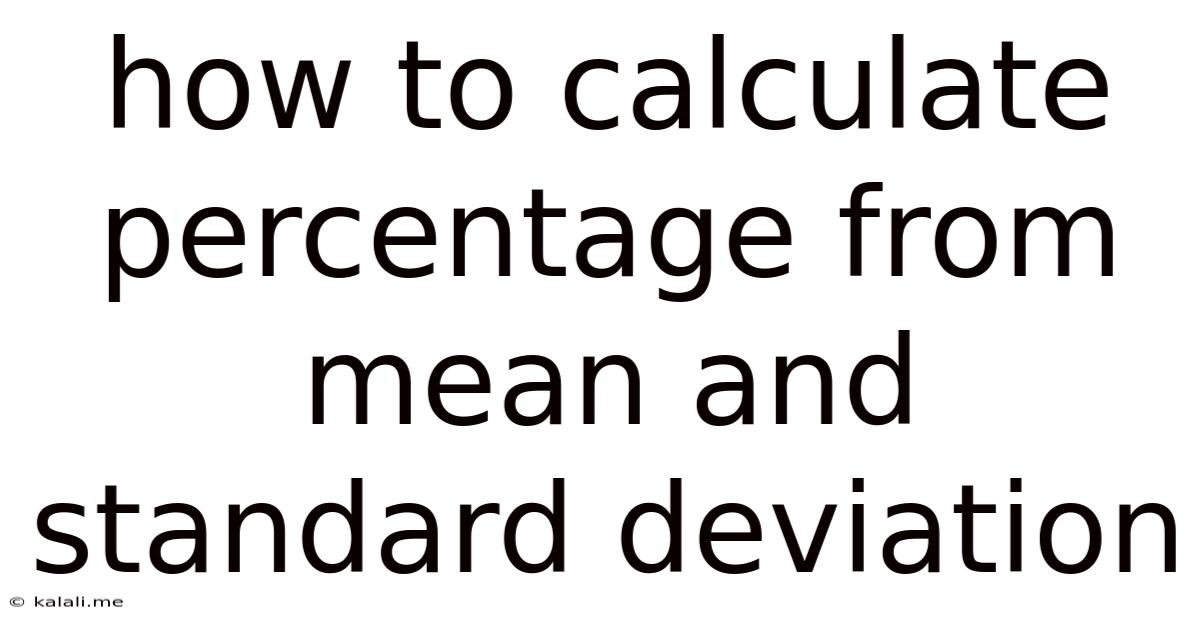How To Calculate Percentage From Mean And Standard Deviation
Kalali
Jun 10, 2025 · 3 min read

Table of Contents
How to Calculate Percentage from Mean and Standard Deviation
Understanding how to calculate percentages based on mean and standard deviation is crucial in various fields, from statistics and data analysis to finance and quality control. This article will guide you through the process, explaining the concepts and providing practical examples. We'll explore how to determine the percentage of data points falling within specific standard deviations from the mean, a process often used to understand data distribution and identify outliers.
Understanding the concepts of mean and standard deviation is fundamental. The mean (average) represents the central tendency of a dataset, while the standard deviation measures the spread or dispersion of data points around the mean. A smaller standard deviation indicates data points are clustered closely around the mean, while a larger standard deviation shows more dispersion.
Calculating Percentages using Z-scores
The most common method for calculating percentages involves using z-scores. A z-score represents how many standard deviations a data point is from the mean. The formula for calculating a z-score is:
z = (x - μ) / σ
Where:
- x is the individual data point
- μ (mu) is the population mean
- σ (sigma) is the population standard deviation
Once you have the z-score, you can use a z-table (or statistical software) to find the corresponding cumulative probability. This probability represents the percentage of data points falling below that specific z-score.
Examples
Let's illustrate with a practical example. Suppose we have a dataset representing the heights of students, with a mean (μ) of 170 cm and a standard deviation (σ) of 10 cm. We want to find the percentage of students with heights between 160 cm and 180 cm.
-
Calculate z-scores:
- For x = 160 cm: z = (160 - 170) / 10 = -1
- For x = 180 cm: z = (180 - 170) / 10 = 1
-
Consult a z-table:
- A z-score of -1 corresponds to a cumulative probability of approximately 0.1587 (or 15.87%). This means 15.87% of students are shorter than 160 cm.
- A z-score of 1 corresponds to a cumulative probability of approximately 0.8413 (or 84.13%). This means 84.13% of students are shorter than 180 cm.
-
Calculate the percentage between 160 cm and 180 cm:
-
Subtract the probability for z = -1 from the probability for z = 1: 0.8413 - 0.1587 = 0.6826
-
Therefore, approximately 68.26% of students have heights between 160 cm and 180 cm. This aligns with the empirical rule which states that approximately 68% of data falls within one standard deviation of the mean.
-
Using Statistical Software
Statistical software packages like R, Python (with libraries like SciPy), or Excel can simplify these calculations. These tools provide functions for calculating z-scores and probabilities directly, eliminating the need for manual z-table lookups. They also offer more advanced statistical analyses beyond the basic percentage calculations described here.
Beyond One Standard Deviation
Remember, the example above focuses on the percentage within one standard deviation of the mean. You can apply the same process to calculate percentages within two standard deviations (approximately 95%) or three standard deviations (approximately 99.7%). Simply calculate the z-scores for the corresponding limits and use a z-table or statistical software to find the cumulative probabilities.
Understanding how to calculate percentages from mean and standard deviation provides valuable insights into data distribution and allows for more informed decision-making in various contexts. While z-scores and z-tables are fundamental, utilizing statistical software can greatly streamline the process, especially for more complex analyses.
Latest Posts
Latest Posts
-
How Many Cups In A Pound Of Hamburger Meat
Jul 02, 2025
-
Imagery Or Figurative Language From Romeo And Juliet
Jul 02, 2025
-
What Is A Quarter Of A Million
Jul 02, 2025
-
Which Of The Following Is True Concerning A Dao
Jul 02, 2025
-
How Long Can Catfish Live Out Of Water
Jul 02, 2025
Related Post
Thank you for visiting our website which covers about How To Calculate Percentage From Mean And Standard Deviation . We hope the information provided has been useful to you. Feel free to contact us if you have any questions or need further assistance. See you next time and don't miss to bookmark.